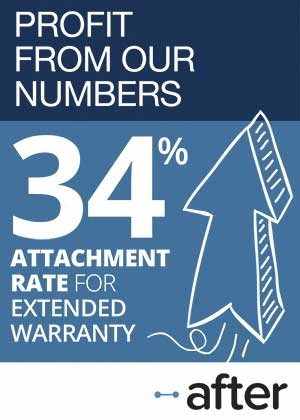Extended Warranty Insurance Companies:
The advice columns tell you not to buy extended warranties, but they never tell you not to buy extended warranty companies. Of the four largest publicly traded warranty insurance companies, at least two offer dependable dividend yields and perhaps also capital gains as the recovery takes hold on Wall Street.
Ignore the earnest pleadings of all those consumer advocates who say that extended warranties are rarely worth the price. Somebody's apparently buying them, because some of the insurance companies that back them up are reporting healthy revenues, rising earnings and increasing dividends.
We're not talking about more mainstream property and casualty insurance companies such as Travelers and Chubb. We're not talking about life insurance companies such as MetLife and Prudential. We're not talking about auto insurance companies such as Allstate or Geico. And we're not talking about health insurance companies such as Aetna or Blue Cross/Blue Shield.
No, this is a niche within a niche. The service contract and extended warranty underwriters are nestled within the specialty insurance sector of the industry, which gets little attention. We're talking about companies such as Assurant Inc. (AIZ), parent of Assurant Solutions; American International Group Inc. (AIG), parent of AIG Warranty; AmTrust Financial Services Inc. (AFSI), parent of AMT Warranty; and the American Financial Group Inc. (AFG), parent of the Great American Insurance Co., Premier Lease & Loan Services, and Premier Dealer Services Inc.
With the exception of AIG, these company share numerous traits. First, they're not all that large, with Assurant and American Financial Group having around $25 billion in assets and AmTrust having around $3.1 billion. Second, they're relatively stable and well-capitalized, which is why they're hardly ever mentioned in the same sentence as AIG. And third, they're quiet and behind-the-scenes players who nevertheless utterly dominate the extended warranty underwriting business (with the possible addition of a few Canadian and European companies).
Centuries-Old Legacies
Some of these companies have roots that stretch back into the 19th century. Great American wrote its first policy on March 19, 1872. The Hartford Steam Boiler Inspection & Insurance Co., which until last month was part of AIG, goes back to 1866.
And then there are the extended warranty and service contract underwriters that only recently became independent. AmTrust was a workers' compensation insurance company that was spun off from computer maker Wang Laboratories only 11 years ago, and it didn't go public until late 2006. Assurant Inc. went public in early 2004, after separating from Fortis SA/NV, the Belgian/Dutch insurance company.
Both AmTrust and Assurant, we should note, are sponsors of this newsletter. Because of that sponsorship, and because the potential conflicts of interest would only multiply if we actually ever invested in either of those companies, we're only going to pretend to be investors this week. But readers who think they can remain free of any potential conflicts are welcome to take a taste of the shares of AIZ, AIG, AFSI or perhaps AFG.
Until greedy billionaires figured out a way to bring down the Western financial system last fall with their toxic credit default swaps, the banking and insurance industries were not known for making headlines about their reckles ways. And one of the biggest problems the well-run banks and insurance companies now have is finding a way to differentiate themselves from the cowboys who ran their companies into the ground or into the arms of the regulators last year.
Even within AIG, there are numerous safe and steady units that never generated much publicity. However, because one AIG unit figured out a way to sell what amounted to debt insurance on debts that nobody knew were toxic, the company's soon-to-be-abandoned acronym is destined to go down in history as one of the biggest casualties of the panic of 2008. AIG's common shares have fallen so far and so fast that most of its investors didn't know what hit them until it was too late.
Making a Small Fortune
Let's put it this way: A year ago, in May 2008, four months before the panic began, AIG raised a total of approximately $7.5 billion through the sale of 196.7 million shares of common stock at a price of $38 per share. At yesterday's closing price of $1.60 per share, those shares are now worth $315 million, a decline of 96%.
To put it another way: a million dollars invested in those shares a year ago would today be worth only $42,100. As the old quip goes, you could make a small fortune ... out of a large one. Then again, AIG shares were up 15% today, so obviously the volatility works in both directions.
But you have to wonder: what will that $42,100 portfolio be worth in a year? Will those shares once again be worth a million dollars? Or will they be worthless?
Here's a chart that shows last September's free fall in AIG shares -- what day traders call a waterfall pattern. Although the scale makes it look like the shares fell to zero and then flat-lined, they have in fact since gone as low as 33 cents in early March and as high as $2.00 earlier this month. By the way, for anyone who got in and got out at those extreme price points, the 60-day return would have been 509%.
Figure 1
AIG Common Stock Price
(US$ per share, 2008-2009)
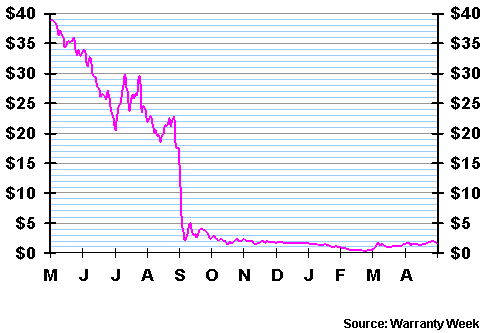
As one could surmise from Figure 1, the financial panic went into high gear over the weekend of September 12-14, 2008. The following week, Lehman Brothers went bankrupt, Merrill Lynch went into the arms of the Bank of America, and AIG went into the arms of the U.S. government. On September 22, AIG accepted $85 billion from the Federal Reserve Bank of New York and issued 100,000 shares of Series C Perpetual, Convertible, Participating Preferred Stock to the U.S. Treasury Dept., the first of several injections of government funds designed to keep the company afloat. To date, AIG has received $182.5 billion in financial support of one kind or another from the U.S. government. And its market capitalization is still not quite back up to $5 billion.
AIG Warranty
In the middle of it all, AIG Warranty has continued to do business more or less the same as ever. Oh yeah, did we mention that AIG is one of the major players in the extended warranty insurance underwriting business? It is the insurance provider that backs up the extended warranty operations of Wal-Mart, Best Buy, and others, with a total of over 60 million service contracts sold to date.
However, in the overall scheme of things, AIG Warranty is just a very small part of the company. One could be forgiven for losing sight of AIG Warranty in the midst of all this financial turmoil. Its home is within one of AIG's General Insurance subsidiaries, the AIG Property Casualty Group, which in turn is comprised of Commercial Insurance, Transatlantic, Personal Lines and Mortgage Guaranty units. AIG Warranty is part of the Commercial Insurance unit.
Here's how AIG describes the organization:
"AIG's primary property casualty division is Commercial Insurance. Commercial Insurance's business in the United States and Canada is conducted through American Home, National Union, Lexington, HSB and certain other General Insurance company subsidiaries of AIG. During 2008, Commercial Insurance accounted for 47 percent of AIG's General Insurance net premiums written.
"In addition to writing substantially all classes of business insurance, including large commercial or industrial property insurance, excess liability, inland marine, environmental, workers' compensation and excess and umbrella coverages, Commercial Insurance offers many specialized forms of insurance such as aviation, accident and health, equipment breakdown, directors and officers liability (D&O), difference-in-conditions, kidnap-ransom, export credit and political risk, and various types of professional errors and omissions coverages.
"Also included in Commercial Insurance are the operations of AIG Risk Management, which provides insurance and risk management programs for large corporate customers and is a leading provider of customized structured insurance products, and AIG Environmental, which focuses specifically on providing specialty products to clients with environmental exposures. Lexington writes surplus lines for risks on which conventional insurance companies do not readily provide insurance coverage, either because of complexity or because the coverage does not lend itself to conventional contracts. The AIG Worldsource Division introduces and coordinates AIG's products and services to U.S.-based multinational clients and foreign corporations doing business in the U.S."
Separately, AIG Warranty describes itself as follows:
"With over 20 years of experience providing extended service contract programs -- nine of the top 30 U.S. retailers rely on us. As an industry leader in developing new products that support individual client needs is second to none. Our ESC programs cover a vast spectrum of consumer products, from home appliances, electronics, computers to outdoor power equipment, and can be customized quickly to suit a full lineup of merchandise. Our programs are ideal for retailers and manufacturers that are looking to maintain their competitive edge and provide value-added services that differentiate them from the competition."
Return on Investment?
Of course, the most important question is, if one buys AIG shares at $1.60 (or at today's closing price of $1.84), will those shares increase or decrease in value? The dividend was eliminated in September and it won't be back any time soon, so the only reason for buying the shares is a belief that they will increase in value over time.
AIG is losing money by the truckload, but keep in mind that some of that is part of a governmental mandate for the company to unwind the debt insurance positions that got it into so much financial trouble to begin with. AIG Financial Products Corp., the subsidiary that sold the debt insurance, expects to unwind the vast majority of its "credit default swaps" within the next year.
In the mean time, the financial figures will suffer. During the first quarter of 2009, AIG's General Insurance Group reported $10.69 billion in revenue and a $1 million operating loss. In the same quarter of 2008, the group reported $12.29 billion in revenue and operating income of $1.34 billion. First quarter revenue included a $251 million gain on the sale of Hartford Steam Boiler.
During the first quarter of 2009, AIG's Commercial Insurance Group reported $5.21 billion in revenue and $22 million in operating income. In the same quarter of 2008, the group reported $5.99 billion in revenue and operating income of $785 million.
So let's assume we bought $42,100 worth of AIG stock yesterday at a price of $1.60 per share. It would have gone up in value by more than $6,000 today, thanks to the good news that AIG plans to sell shares of one of its Asian subsidiaries to the public next year. If it goes up by $6,000 every day, in less than nine months we'd have our million dollars back. But if it goes down by $6,000 a day, it would be completely gone before the end of the month. And in this crazy market, either outcome is equally likely. Care to throw the dice?
Steady As She Goes
For investors looking for a less volatile portfolio, Assurant Inc. could provide a pleasing mixture of both dependable dividends and rising share prices. In every quarter since the spring of 2004, Assurant has either maintained or increased its dividend. And the current dividend rate of 14 cents per share, even after allowing for a 57% recent decline in net income, is still below 21% of earnings per share.
In the chart below, it's a long way down from the high $60s where AIZ shares could be found last June and July to the high teens they hit in early March. But, just as with AIG's shares, the big fall could be a prelude to the big rebound. Imagine securing a 2.5% dividend yield and then enjoying a doubling or perhaps even tripling your money with the capital gains.
Figure 2
Assurant Common Stock Price
(US$ per share, 2008-2009)
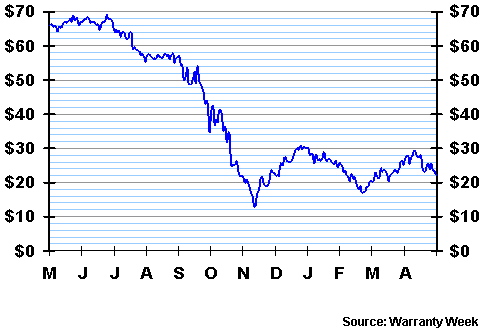
Assurant Solutions is the unit that provides extended service contracts and warranties, preneed life insurance, international credit insurance, and debt protection/debt deferment services. To market its extended service contract and warranty products, Assurant Solutions partners with four of the ten largest consumer electronics and appliance retailers (based on combined product sales).
In its own words, the company states:
"Through partnerships with leading retailers, we underwrite and provide administrative services for extended service contracts and warranties. These contracts provide consumers with coverage on appliances, consumer electronics, personal computers, cellular phones, automobiles and recreational vehicles, protecting them from certain covered losses. We pay the cost of repairing or replacing customers' property in the event of damages due to mechanical breakdown, accidental damage, and casualty losses such as theft, fire, and water damage. Our strategy is to seamlessly provide a total solution to our clients that addresses all aspects of the warranty or extended service contract, including program design and marketing strategy. We provide technologically advanced administration, claims handling and customer service. We believe that we maintain a differentiated position in the marketplace as a provider of both the required administrative infrastructure and insurance underwriting capabilities."
Strategic Acquisitions
Even as its competitors were imploding, Assurant was expanding. On September 26, Assurant acquired the Warranty Management Group unit from GE Consumer & Industrial for $140 million in cash. As part of that acquisition, Assurant also signed a new 10-year agreement to market extended warranties and service contracts on all GE-branded major appliances sold in the U.S. Separately, GE paid Assurant $115 million in cash, which Assurant offset with a $106 million reduction in deferred acquisition costs, and a $9 million reduction in receivables in connection with the termination of the existing strategic alliance.
And then on October 1, Assurant acquired Signal Holdings LLC, a leading provider of wireless handset protection programs and repair services, for $257.4 million in cash. Assurant said Signal generates annual revenues of approximately $330 million through servicing extended service contracts for 4.2 million wireless subscribers. No need to reach for those calculators: that's $6.55 per subscriber per month.
Assurant Solutions reported $1.53 billion in gross written premium for domestic extended service contracts and warranties in 2008, down from the $1.83 billion reported in 2007. International extended service contract and warranty gross written premium was up, however, from $422.7 million in 2007 to $477.7 million in 2008.
Net earned premiums for service contracts were up 22%, from $1.4 billion in 2007 to $1.72 billion in 2008. Growth continued into the first quarter of 2009, when net earned premiums for service contracts rose another 9% to $434 million for the quarter.
Net income, however, is down -- by 32% for the year and by 57% for the most recent quarter. But here's the most important fact: a profit is still a profit. AIG had a net loss of $99 billion last year. Assurant had a net profit of $448 million.
Warranty-Centric Company
Of the four companies we're spotlighting this week, AmTrust Financial Services is perhaps the most warranty-centric of them all. While around 22% of Assurant's total net earned premiums come from service contracts, and an unknown-but-smaller percentage of AIG's revenue does as well, fully 35% of AmTrust's net earned premiums come from the Specialty Risk and Extended Warranty Insurance segment.
Just a few days ago the company issued a press release with what may be one of the rarest headlines of the post-Lehman era: "AmTrust Financial Services Inc. announces increased quarterly dividend." [Also, the day after this newsletter was first published, Assurant raised its quarterly dividend from $.14 to $.15 per common share.] Think about that news for a second. As bad as things are supposed to be out there, the most warranty-centric insurance companies continue to raise their dividends year after year!
It's not as if AmTrust's shares have also been soaring since they first began trading in late 2006. In November of 2008 and then again in March of 2009, shares of AFSI briefly went below their initial public offering price, though they're above that level again now. In Figure 3 below, those low points are both evident, as is the recent recovery to a price of $9.50 a share.
Figure 3
AmTrust Common Stock Price
(US$ per share, 2008-2009)
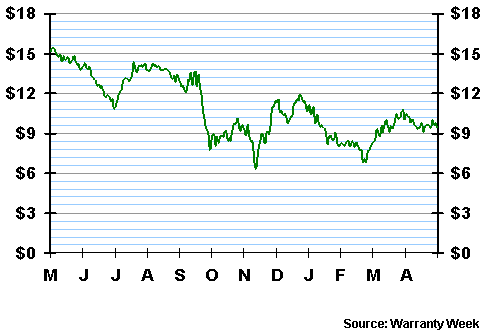
AMT Warranty Corp. is the name of the relevant subsidiary within the Specialty Risk and Extended Warranty Insurance segment. It underwrites service contracts for not only the main categories of PCs, appliances, home electronics and autos, but also hand tools, furniture, heavy equipment, and cell phones, among others.
AmTrust owns 27% of Warrantech Inc., thanks to an acquisition it made along with H.I.G. Capital that took the Texas-based administrator private back in February 2007. The company currently insures a majority of Warrantech's business, which produced gross written premiums of approximately $86.5 million and $41.3 million in 2008 and 2007, respectively. During the first quarters of 2009 and 2008, AmTrust said Warrantech produced gross written premiums of approximately $23.0 million and $17.7 million, respectively.
"We believe that the specialty risk and extended warranty sector in which we do business is not as developed as most other insurance sectors," the company's most recent annual report states. "We believe that our competitive advantages include the ability to provide technical assistance to warranty providers, experienced underwriting, resourceful claims management practices and good relations with the leading warranty administrators in the European Union."
Approximately 53% of the extended warranty segment's gross premiums originated in the U.S in 2008, up from 45% in 2007 and 46% in 2006. The UK accounted for 21% in 2008, down from 29% in 2007 and 26% in 2006. AmTrust has an underwriting subsidiary based in Ireland called AIU (AmTrust International Underwriters Limited), which underwrites specialty risk and extended warranty coverage plans in the European Union.
AIU Shoot-Out?
Interestingly, AIG recently changed the name of its overseas property casualty operations to American International Underwriters, setting up a potential battle of the AIUs. Perhaps one day AmTrust will sponsor another member of the UK's Premier League such as Liverpool (AIG has its logo on the Manchester United team's jerseys) and the two rivals can do penalty kicks to see who gets to keep the name?
The fourth member of our dream portfolio is the American Financial Group Inc., primarily because of its subsidiaries the Great American Insurance Co., Premier Lease & Loan Services, and Premier Dealer Services Inc. Although the company's shares suffered a steep decline at around the same time as AIG and the others did in September, AFG shares fell the least of the four on a percentage basis.
Figure 4
American Financial Group Common Stock Price
(US$ per share, 2008-2009)

AFG includes its extended warranty business in the "other income" category. In the first quarter of 2009, "other income" declined to $62.9 million, from $72.1 million in the same period of 2008. AFG said the $9.2 million decrease, "reflects a $6.5 million decline in income from AFG's warranty business and lower fee income in certain other businesses."
This probably means that American Financial Group is the smallest of the four companies in the warranty business. AmTrust is a smaller company in terms of assets and revenue, but a larger share of the company is in the warranty business.
Dividend Yields
The good news, however, is that the American Financial Group also has the highest dividend yield. In 2008 and 2007, AFG declared and paid dividends of 50 cents and 40 cents per share, respectively. In January 2009, AFG increased its quarterly dividend to 13 cents per share, so its annual dividend should be 52 cents unless there are additional changes later this year. With the current share price around $20, that would represent a yield a little above 2.5%.
If the dividend rises, the yield will rise as well. If the dividend remains the same, the effective yield can still rise if the stock price falls. But that would matter only to someone who doesn't yet own the stock. The yield is always whatever you pay for your shares divided into the dividend you receive per year.
In Figure 5, we're plotting the yield curves of the four companies for the past year. Only AIG has discontinued its dividend, and none of the other three has reduced theirs. In fact, two have recently announced slight increases.
Figure 5
AFSI, AFG, AIZ & AIG
Dividend Yield in Percent, 2008-2009
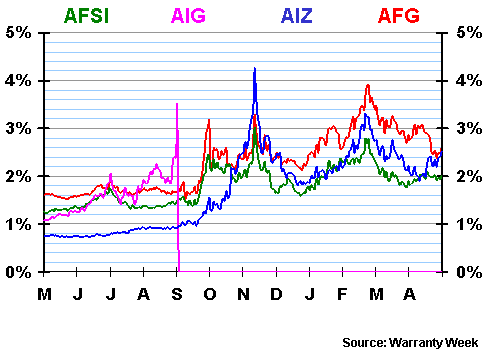
Notice the twin spikes at November 20 and March 5. Those are the dates, more or less, that many bank and insurance stocks hit their lowest prices of 2008 and 2009, respectively. As their stock prices dove, however, the dividends remained the same, so in some cases the yields temporarily spiked above 3% and even 4%. As of today, AFSI yields 2%, while AIZ yields 2.4% and AFG yields 2.5%. That's the yields you'd get if you bought your shares today.
There's nothing really compelling or exciting about those yields, though. Federally insured savings accounts used to yield more in simple interest. However, because all four dividends represent a relatively low percentage of earnings per share, all three seem quite safe. AFSI pays out only 13% of its earnings in dividends. AFG pays out 15%. AIZ pays out 21%. Even AIG, back in the good old days of 2007, was paying out only 31% of its earnings in dividends. Then again, now there is no dividend at all, and no earnings either.
Normalizing the Stock Prices
The last measure we wanted to show is a chart that sets all four share prices to equal 100 on May 14, 2008. As can be seen in Figure 6, AFG fell the least and recovered the most, at least so far.
Figure 6
AFSI, AFG, AIZ & AIG Stock Prices
(May 14, 2008 = 100)
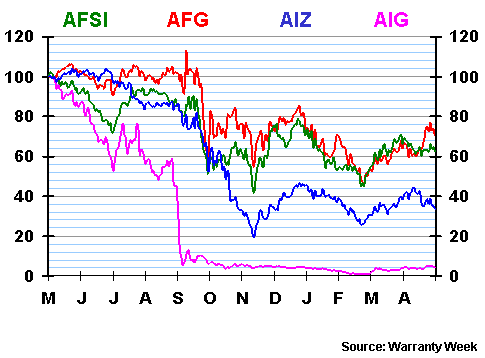
AIG of course fell the most and recovered the least. And there's such a slim chance that it will ever return to its $38 levels of a year ago. AFSI has closely tracked AFG since the panic began, at least until the last few weeks when AFG shot up from $16 to $20 while AFSI remained stuck around $9 or $10.
Assurant is the most intriguing of the bunch. For an outside investor, it promises both a "safe" 2.4% dividend and the prospect of a doubling or even tripling of its share price as the recovery takes hold. While it's up more than 85% from its lows for the year, it's still reclaimed only a fraction of its $71 peak price per share. That's probably because Assurantgot lumped in with all the bad banks and reckless insurance companies, despite its safe and steady business model.
So here's what we're going to do. We already invested $42,100 of our imaginary money yesterday in AIG. Let's say we invest the same amount in Assurant at the May 13 closing price of $22.14 a share, and the same amount of AFG at $19.51 a share, and the same amount of AFSI at $9.44 a share. We'd have a portfolio of four stocks worth a collective $168,400.
The first thing we'd notice is that our imaginary portfolio grew by $10,750 today, as two of the warranty insurance stocks rose by 5% and one rose by 15%. And thanks to those big leaps, our AIG stock is now 27% of the portfolio, up from 25% only yesterday. If every day is this good, we'll be imaginary millionaires by June.






